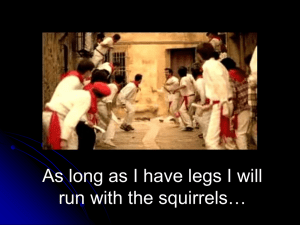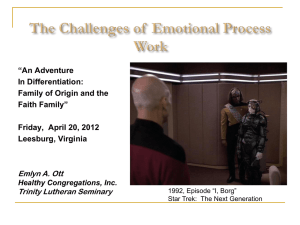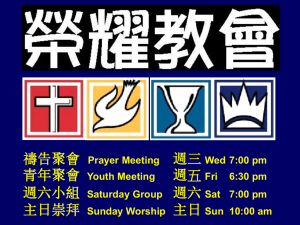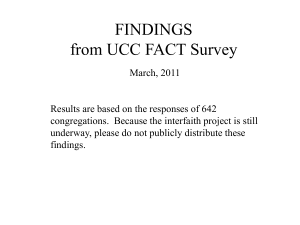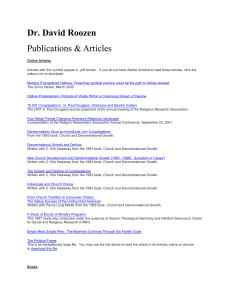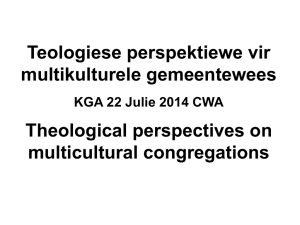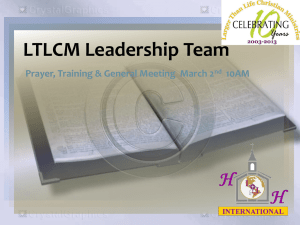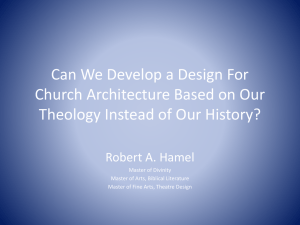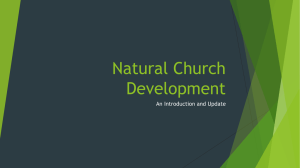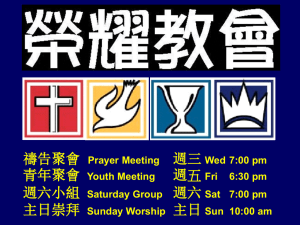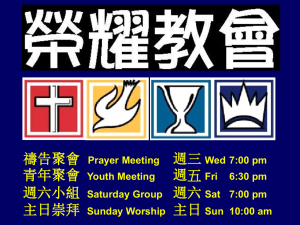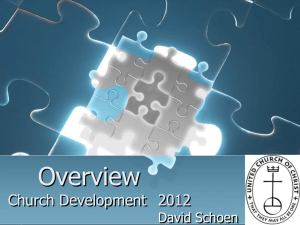Three Fundamental Religious Changes in America
advertisement
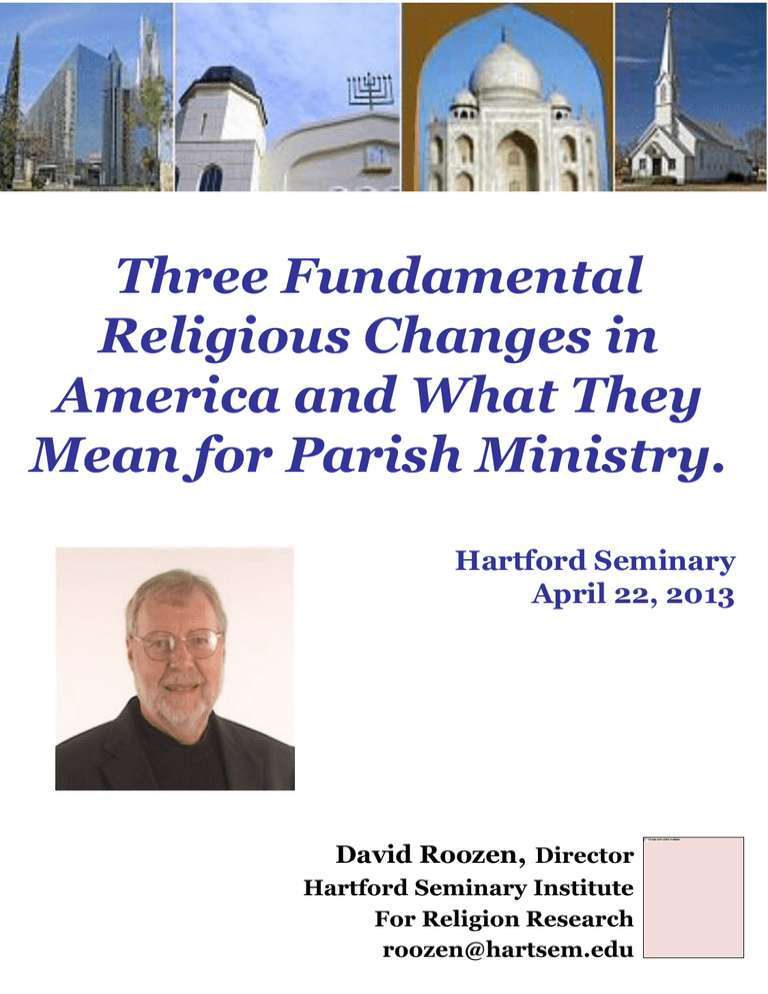
Three Fundamental Religious Changes in America and What They Mean for Parish Ministry. Hartford Seminary April 22, 2013 David Roozen, Director Hartford Seminary Institute For Religion Research roozen@hartsem.edu In Regard to Religious Change: Not A Good Half Century For the United States 1941 -- 2004 Declines Have Accelerated in the Last Decade Five Year Rate of Growth or Decline in Membership Based on data from the Yearbook of American and Canadian Churches Episcopal Presbyterian-USA United Church of Christ Church of the Brethren Evangelical Lutheran-ELCA Reformed Church of Am United Methodist Christian and Missionary Alliance Cumberland Presbyterian Evangelical Covenant Lutheran Church, Missouri Synod N.A. Baptist Conf 7th Day Adventist Southern Baptist Conv Wisc Evang Lutheran Synod Assemblies of God Church of God-Anderson Church of God-Cleveland Church of Nazarene Free Methoddist of N.A. Salvation Army DAVID ROOZEN ROOZEN@HARTSEM.EDU And It Is Not Just A Matter of People in the Pews, But Also: A Steep Drop in Financial Health And, a Nearly Equal Drop in The Spiritual Vitality of Congregations But The Declines Are Only The “Glass Half Empty” Take On The Decade, which also includes, among other negatives: Continuing high levels of conflict, and Aging memberships. On The Positive Side, The Decade Brought: 1. A continued increase in innovative, adaptive worship 2. A surprisingly rapid adoption of electronic technologies 3. A dramatic increase in racial/ethnic congregations, many for immigrant groups 4. A general increase in the breadth of both member-oriented and mission oriented programs The decade also gave Witness to: 5. An increase in connection across faith traditions 6. A twist in the historical pattern of religious involvement in the electoral process www.FaithCommunitiesToday.org Within This Tangled Swirl Of American Religious Change, Our Brief Time Today Only Allows A Very Cursory Look At Three Threads: The Ascendance of Innovative Worship The Corrosive, Yet Also Potentially Energizing Effect of Conflict The Opportunities and Challenges of Increasing Racial/Ethnic Diversity Further Resources on Congregations & Change Hartford Seminary Courses and Events, www.hartsem.edu Webinar: Supersized Believers: What Megachurches Tell Us About The Spiritual State of Americans And How to ReachThem Thursday, May 23, 2013 at 8 p.m. Course: American Religious Trends: Changing World, Changing Ministry Monday, June 3 through Friday, June 7, 9 a.m. to 5:30 p.m Hartford Institute Publications, www.FaithCommunitiesToday.org/ The Other 80 Percent: Turning Your Church's Spectators into Active Participants Scott Thumma, Warrant Bird FACTs on Growth 2010 C. Kirk Hadaway Most recent and encyclopedic book on religious change in the united States American Grace: How Religion Divides and Unites Us Robert D. Putnam and David E. Campbell A Final Word of Preface To help Set The Broader Context: Three Foundational, MEGA-TRENDS Changing America’s Religious Landscape • From WORD to SPIRIT • From PROPHETIC to POLITICAL • From MISSION to WORSHIP DAVID ROOZEN Of these, the transition from Word to Spirit Is the Most Profound and Foundational It is not uncommon – indeed it is most typical – for persons to think of religion as a collection of beliefs and doctrines most closely tied to, if not directly drawn from, a sacred Scripture. The beliefs, doctrines and scripture are cognitive and objective (i.e., they are external to the believer). Worship in such a tradition tends to emphasize preaching and the style of preaching is expository. This is what I mean by a religious orientation grounded in THE WORD. In contrast, we are becoming increasingly aware that many persons practice religion more in terms of a liturgical or personal relationship to God. Such an approach is more experiential and subjective. (i.e., it is internal to the believer). Worship in such a tradition emphasizes ritual and/or prayer and the gifts of the spirit. If preaching is included it tends to be narrative. This is what I mean by a religious perspective oriented to THE SPIRIT. The transition from WORD to SPIRIT is, most profoundly, a transition from an EXTERNAL to an INTERNAL locus of authority, and part and partial of this transition is religion as CHOICE. Baby boomer carried Cultural Revolution of the 1960s with its: Cultural individualism Ethic of self-fulfillment Anti-establismentarianism Church as choice Spiritual Marketplace: Baby Boomers and the Remaking of American Religion Wade Clark Roof The ‘Moralistic Therapeutic Deism” of the Millenials. Souls in Transition: The Religious and Spiritual Lives of Emerging Adults Christian Smith With Patricia Snell Still the best single book for understanding the implications of different generationallyrelated cultural worlds for congregational life! U. S. Lifestyles and Mainline Churches : A Key to Researching People in the 90's Tex Sample • From PROPHETIC to POLITICAL DAVID ROOZEN • From MISSION to WORSHIP DAVID ROOZEN A Continued Increase in Innovative, Adaptive Worship ‘Nowhere is the democratization of the sacred more evident than in the music sung in new paradigm churches. It is populist, written by common people whose lives have been transformed. And it is contemporary, drawing on the musical forms of popular culture. Social movements, both secular and religious, have often been accompanied by a radical shift in musical expression. Music reflects the deep unconscious structures of a culture, and correspondingly, the music of social movements signals discord with those routinized structures. Movement music simultaneously symbolizes a break with the old and provides a source of cohesion for those choosing the new way.” Reinventing American Protestantism: Christianity In the New Millennium, Donald E. Miller But It Is Really Innovative Worship That Pays The Strongest Vitality Dividend Think for a moment – What is the most magnificent & inspirational worship service you have ever experienced? Would your worship attendance increase if every service was like this? Would the depth of your spiritual commitment deepen? What kind of worship might do the same things for your kids/ grand children/ nieces or nephews? Conflict In One or More of Four Key Areas* in Past Five Years Continuing High Levels of Conflict % Congregations 75.0% 64.2% 65.1% 2000 2010 50.0% 25.0% 0.0% *Four Key Areas: Worship Finances Program Priorities Leadership Conflict Typically Thought Of As, And Can In Fact Be A Bad Thing No Conflict Some Minor Conflict Some Serious Conflict 75% Any Conflict % of Congregations that Reported Consequences of Conflict 69% 50% 39% 25% 25% 0% So me M emb er s Lef t Lead er Lef t * M o ney W it hheld But The Most Significant Implication of Conflict for Congregations Today Is Conflicts Relationship To CHANGE Vitality and Growth Typically Require Change Percent Rapid Attendance Growth Change Typically Produces Conflict 60% 50% 50.1% 40% 30% Percent Serious Worship Conflict 33.7% 25% 20% 20% 10% 21.8% 15% 0% Little or None Some or A Lot 10% Worship Change In Past 5 Years 5% 11.8% 0% Little or None Some or A Lot Vitality and Growth Typically Require Managing Conflict Worship Change In Past 5 Years Percent Rapid Attendance Growth 60% 55.8% 51.7% Worship Change 50% 40% 32.4% 30% 32.5% 37.6% 29.1% Little or None Some Or A Lot 20% 10% 0% None Minor Serious Worship Conflict % Congregations: Serious Conflict over Worship Buffers AgainstSerious Serious Conflict Buffers Against Conflict 30% 26% 23% 20% 16% 15% 11% 10% Fortunately, There Are Resources For Dealing With Conflict 10% 0% Family Feeling Low Purposefulness Moderate High Insights Into: Congregational Conflict Is your congregation going through a period of conflict that you aren't sure how to handle? Or are you interested in preparing to better handle future conflicts? This publication offers research, tips and resources to help clergy, seminarians, and congregational leaders deal constructively with this inevitable part of congregational life. Download it @ www.FaithCommunitiesToday.org Resolving Church Conflicts: A Case Study Approach for Local Congregations by G. Douglass Lewis Considerably More Predominantly Racial/Ethnic Minority Ethnic Congregations: % Of All U.S. Congregations 50% % Congregations 40% 37.0% 30.8% 29.3% 30% 22.6% 20% 11.4% 10% 7.3% 2000 2010 0% All Congregations Oldline Protestant Evangelical Protestant Ten percent Or More 5-Year Attendance Growth And, More Likely To Be Growing The Number of Multiracial Congregations is also Increasing (Congregations with no more than 80% of participants from any given racial/ethnic group) Percent Multiracial Congregations 15% 2010 Percent Multiracial Congregations By Family 13.7% 10% 5% 7.5% 0% 1998 2010 Percent Rapidly Growing 35.4% 27.1% 14.4% 7.4% Oldline Evang Cath & World Prot Prot Ortho Relig 50% 47.9% 40% 30% 35% 30% 25% 20% 15% 10% 5% 0% 36.9% 20% 10% 0% Not MultiracialMultiracial Further Resources on Congregations & Change Hartford Seminary Courses and Events, www.hartsem.edu Webinar: Supersized Believers: What Megachurches Tell Us About The Spiritual State of Americans And How to ReachThem Thursday, May 23, 2013 at 8 p.m. Course: American Religious Trends: Changing World, Changing Ministry Monday, June 3 through Friday, June 7, 9 a.m. to 5:30 p.m Hartford Institute Publications, www.FaithCommunitiesToday.org/ The Other 80 Percent: Turning Your Church's Spectators into Active Participants Scott Thumma, Warrant Bird FACTs on Growth 2010 C. Kirk Hadaway A Decade of Change in American Congregations: 2000 - 2010 David A. Roozen Most recent and encyclopedic book on religious change in the united States American Grace: How Religion Divides and Unites Us Robert D. Putnam and David E. Campbell David Roozen, Director Hartford Seminary Institute For Religion Research roozen@hartsem.edu
